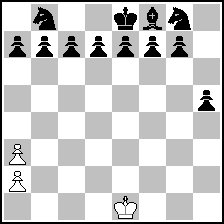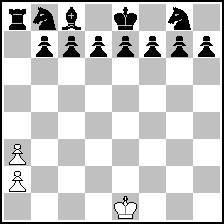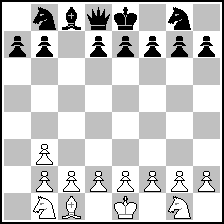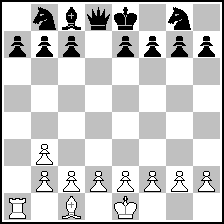|
|
| (1) Posted by James Malcom [Monday, Dec 14, 2020 08:40] |
Construction challenge: Find the best economy such that a piece type's capture location can be determine
I had a little thought today, just thought provocative and not altogether too interesting. How few pieces may be needed to determine exactly where a piece was captured? I bring it here for some brain food. There are just Type A/B (No difference here really) and Type C challenges.
To narrow down the field right away, 14/16 pawns can be down with Type C, due to considerations with reflection, rotation, and color swapping, with just 5 pieces
Capture location of bPg7?
 (= 4+1 ) (= 4+1 )
This leaves us with only 7 cases to wash out-queen, rook, bishop, knight, edge pawn, and middle pawn Type A/B. I also say home square captures-too easy! Even if promoted, that piece still semi-counts as it the missing pawn.
Here are my hastily done ideas.
Piece type captured on h3?
 (= 3+11 ) (= 3+11 )
Piece type captured on a3?
 (= 3+12 ) (= 3+12 )
Piece type captured on a3?
 (= 3+12 ) (= 3+12 )
Piece type captured on a3?
 (= 3+10 ) (= 3+10 )
Piece type captured on a3?
 (= 3+12 ) (= 3+12 )
Piece type captured on d3?
 (= 4+12 ) (= 4+12 )
|
|
| (2) Posted by Hauke Reddmann [Monday, Dec 14, 2020 11:32] |
James, I see a problem with the last two diagrams:
Can't the pawn promote and then sacrifice?
|
|
| (3) Posted by James Malcom [Monday, Dec 14, 2020 15:10] |
I already addressed that with "Even if promoted, that piece still semi-counts as it the missing pawn."
|
|
| (4) Posted by Ulrich Voigt [Monday, Dec 14, 2020 15:29] |
And how would you know it was the promoted piece that was captured at c3?
|
|
| (5) Posted by James Malcom [Monday, Dec 14, 2020 16:10] |
Ulrich, look at the Black structure. Only the missing Black pawn, or it's promoted counterpart, was captured by a White pawn-look at the White pawn structure.
|
|
| (6) Posted by Ulrich Voigt [Monday, Dec 14, 2020 16:20] |
So you say the piece captured at c3 couldn't have been one of the original knights?
|
|
| (7) Posted by Hauke Reddmann [Monday, Dec 14, 2020 17:23] |
Funny that Andrew hasn't chimed in yet - "Passenger rooks", an article
in the brand new SCHWALBE, seems sorta related. (The article
ask for the provably first move of a piece. This obviously is the last,
so to say. It seems to me that many of the first moves in the article
are also the last, since the piece got stuck in the diagram.)
|
|
| (8) Posted by James Malcom [Monday, Dec 14, 2020 17:49] |
Well, Hauke, I've already read "Passenger Rooks"-this was a thought branch from it.
And I see you're point Ulrich. It musters heavy force, but the promotion cooks can be out ruled.
Edge Pawn, Correction
 (= 15+12 ) (= 15+12 )
Middle Pawn, Correction
 (= 12+12 ) (= 12+12 )
|
|
| (9) Posted by Joost de Heer [Monday, Dec 14, 2020 21:24] |
Middle pawn can be done slightly cheaper:
 (= 11+12 ) (= 11+12 )
|
|
| (10) Posted by Hauke Reddmann [Wednesday, Dec 16, 2020 11:46] |
Generic question to this theme:
Assume the game went something like
bSxf1,bSxc1,wSb6,baxb6,bRb3,waxb3,wRc5,bbxc5.
I think the order is mostly forced, especially
a white rook sacrificed on c5.
Now it could also have been the h1 rook,
but since White can castle, he can castle!
Is that convention true in the proof game genre too?
|
|
| (11) Posted by Guus Rol [Wednesday, Dec 16, 2020 17:09] |
@Hauke: If you don't know the history, you may only assume castling permission. Once you castle you know you did have castling right in hindsight. You have to destroy it (by castling) to see it. Commonly you will never find out after you played e.g. Ke1-d1. There are some special ways to prove castling right without castling like DP. And in retractors all you need to do is retract the castling move since all retraction choices are free of charge.
I didn't refer to proof games since these give extra information by specifying n-moves. What Joost writes about that is true of course!
|
|
| (12) Posted by Joost de Heer [Wednesday, Dec 16, 2020 17:14] |
Castling rights for a proofgame diagram are almost always irrelevant since there's usually no forward play. There are some examples with a stipulation like 'Position after black's 23rd move. #1. Game?' where the only #1 is castling, so you have to find a proofgame that preserves the castling rights.
And there are of course proofgames in n moves where the position after n-1/2 moves is dualistic, because the last move of the proofgame itself is castling, and the position before the last move could've been reached with the castling rights destroyed.
|
|
No more posts |
MatPlus.Net  Forum Forum  General General  Construction challenge: Find the best economy such that a piece type's capture location can be determine Construction challenge: Find the best economy such that a piece type's capture location can be determine |
 ISC 2025
ISC 2025 Forum
Forum  General
General  Construction challenge: Find the best economy such that a piece type's capture location can be determine
Construction challenge: Find the best economy such that a piece type's capture location can be determine 


